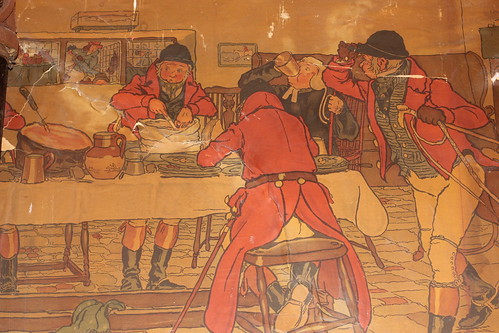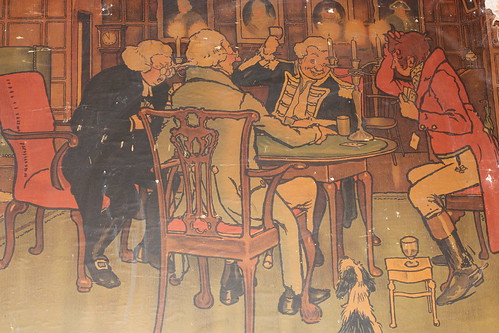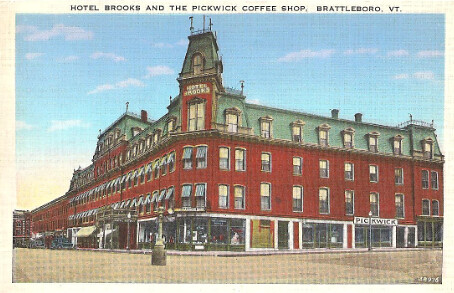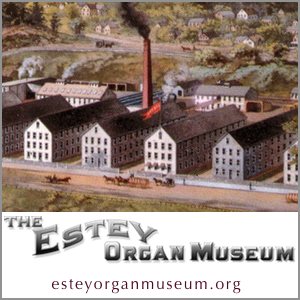The prints seen above were found on walls of the Brooks House during the ongoing renovations.
As the organizer of the T. P. James, “Write Like the Dickens Writing Contest” that will be held October 6, as part of the Brattleboro Literary Festival, I was delighted to learn in subsequent conversation with John Carnahan and in subsequent research, that the Brooks House used to house the “Pickwick Coffeeshop”. The images are presumably scences from The Pickwick Papers, though someome more familiar with that novel may be better able than I to confirm that. Any takers ?
An image from a postcard I found online shows the location of this coffee shop. Cecil LaLoin apparently made other prints in the year 1909. I am no expert in postcards, but it has the look to my eye of colorized postcards of about the same era.
I hope to succesfully remove this print from the wall, with professional advice that I am seeking from the Notheast Document Conservation Center. If any reason that does not work out, at least we have these images.
(PS For more information on the writing contest based on Dickens, see www.universityofbrattleboro.com )







Gorgeous
Nice find! They look great, and your research is interesting.
If they do get preserved and removed, consider showing them off at the new Brattleboro History Center. : )
the "Pickwick Coffeeshop".
Has a nice ring to it. No?
Treasure!
These are beautiful. I hope they can be saved. Good luck, let us know how it turns out.
Size?
How big are they, btw?
Size
I will get dimensions. In my minds eye, they were about 3 feet wide, but maybe larger.
The Fallowfield Hunt Breakfast at the Three Pigeons
These are images by English illustrator Cecil Charles Windsor Aldin (1870-1935). He was sort of the dean of hunting and country life illustration c1900.
The first image is “The Fallowfield Hunt Breakfast at the Three Pigeons”. It was one of a series of 5 or 6 “chromolithographs” published by Lawrence & Bullen Ltd c1900. The series subject was a hunt; the places depicted were said to be places Aldin knew.
The second image is from a set of two called “Mated and Revoked”, which depicted a chess game and a game of Whist.
He did illustrate the 1910 edition of The Pickwick Papers, but I don’t believe that the above images have anything to do with that book. He also illustrated two of the original 1894 magazine publications of stories from Kipling’s ‘Second Jungle Book’.
Here is the signature
http://www.flickr.com/photos/88361661@N00/9623075833/
Thanks for that Excellent Information. Stevil
However did you come by it all ?
Prints by Cecil Aldin
Cecil Charles Windsor Aldin (1870-1935) was born in Slough, in 1870, and lived near Reading, England. His artistic talent for portraying animals and rural life developed at an early age. He left school at the age of sixteen and, encouraged by his father, a builder by profession but himself a skilled amateur artist, Aldin enrolled in the Royal College of Art. Cecil was later influenced by British sporting artist William Frank Calderon (1865-1943), an artist and teacher who founded The School of Animal Painting in Sussex in 1894 and who was later to teach Sir Alfred Munnings (1878-1959) and Lionel Edwards (1878-1966), two famous British sporting artists also at work in the early twentieth century.
A prolific painter, Aldin is known in particular for his sporting art, sensitive depictions of dogs, horses, and hunting scenes in the English countryside. His gaming images such as Chess & Whist are now considered scarce and highly collectable. He was successful and admired in his own time, as a writer and illustrator of books and magazines, his images becoming more popular with the passage of time. “Cecil Aldin can justly be described as one of the leading spirits in the renaissance of British sporting art” (Alan Horne, The Dictionary of 20th Century British Book Illustrators, p. 67).
But as a painter of renown, he became one of the most popular and successful of all British sporting artists. Aldin is best known for his large prints of hunts, coaching and races. His sporting art featured one of his lifelong passions, hunting. He became famous for his watercolours and humorous prints showing foxhunting scenes in the English countryside, as well as his ability to portray the dogs, horses, and animals that were the protagonists of these scenes. In particular, his special talent in sketching and painting dogs. In a funny pose, the tilt of a head or a cocked ear, Aldin captured the individual character of the many dogs and breeds he worked with. His art shows the camaraderie he felt with his canine friends and models, though his work is never overly cute or sweet.
His serious and exacting portrayal of scenes of hunting, racing and horse portraiture is among the finest in British Sporting Art. Aldin was the Master South Berkshire Hunt. He was elected a member of the Royal Society of British Artists in 1898.
Mated and Revoked
“Mated” and “Revoked” Published Lawrence & Bullen, London & Washington 1901. Splendidly captured by Aldin in the classic caricature of a Chess match, is the twinkle in the eye of the victor as he leans back into his wing-back chair to savor his moment of triumph, whilst filling his clay pipe. The awful truth of defeat sinks into the mind of the vanquished, but fortunately the Butler is a step ahead of him as he is already pouring a restorative Brandy. Two household dogs and a cat are witness to the dramatic scene, which takes place in the panelled saloon of an old country house the paneled vestibule is glimpsed through the open door.
Together with: The hotly contested card game of Whist, The master of the hunt has apparently been unable to follow suit and is receiving the ire of his partner (the Bishop) whilst both the squire and captain are delighted at his demise and the latter raises a glass to defeat of the other partners. A spaniel looks up bemused at the spectacle, which takes place in the panelled room of an old country house. The candle lit room is adorned with ancestral portraits and the trappings of English country life.
The Fallowfield Hunt Breakfast at the Three Pigeons
The Fallowfield Hunt Breakfast at the Three Pigeons. Image of a hunt breakfast taking place at an inn that shows some signs of revelry.
Cecil Charles Windsor Aldin, British (1870-1935) did his first set of hunting prints in 1899, The Fallowfield Hunt. This was a series of six sporting prints in which many of the backgrounds were pastiches of equine destinations that Mr. Aldin had known. He also did a series on inns that have become his best selling work to date. Aldin worked mostly in pastel or watercolor and produced a number of fine etchings in limited editions. His designs can also be seen on the popular Buffalo Deldare pottery.
Mesabi Partners!
Fantastic find.. How did the Artist manage to capture so brilliantly the current owners of the Brooks House 100 years ago.
A stroke of unbelievable foresight to caricature Miskovitch, Richards, Richards, Stevens and Taggard so cleverly.
I look forward to seeing the boys around town in their red coats and I’ll leave you to figor out which one is dressed up as the drinking priest…
From Stevil
Pickwick Coffee Shop, When did it open, and when did it close?
Does anyone know ?
I checked In the Library of Congress newspaper search. Nothing
I found no record of “The Pickwick Coffee Shop” in the Chronichling America list of Vermont Newspapers from 1800’s through to the 1930s. The postcard seems to land somewhere in that time frame.
COMMUNITY OWNED COFFEE SHOP ?
What the heck ? A community owned coffee shop?
Or was it, a community owned hotel?
Someone know what the word “community” refers to on this sign ?
Surely,if it is air conditioned, someone recalls what that means, no ?
HOLY EARLY 20th CENTURY AUTOMOBILE, BATMAN ! ! !
This is a link to the postcard image in lightbox mode.
After opening the link, Double click on the small image.
http://www.flickr.com/photos/88361661@N00/9626564552/lightbox/
In the right hand corner, you will see a couple of automobiles. To my eye they look like fancy cars from the 1930 or late 1920s.
Anyone with better car knowledge wanna chime in ?
1936 amd perhaps earlier
See the second page.
http://books.google.com/books?id=6I_viv1udIcC&pg=PT112&lpg=PT112&dq=pickwick+coffee+shop+brattleboro&source=bl&ots=dZfcg_ONyY&sig=lntXQE8xz3Sub2cA3RyYREYsqjQ&hl=en&sa=X&ei=agEjUpS-AYq_sATyvICADA&ved=0CFAQ6AEwBA#v=onepage&q=pickwick%20coffee%20shop%20brattleboro&f=false
???
“Community owned”?!!
Too well pasted on to remove
We tried to remove the prints, but they were too well attached and fragile to remove.
We stopped mid way as it was a fruitless task.
At least we have the digital photos.
This is such a great thread.
This is such a great thread. Really interesting Brattleboro history.
It’s cool the things that can be found during renovations. My friend was renovating his home recently and found an intact newspaper from the 1870s stuffed in the wall as “insulation.”
The ultimate Brattleboro history holy grail I’d love to find is the Indian petroglyphs that are beneath the water on the Retreat meadows near the Marina. These Indian petroglyphs were carved into a large flat stone. They are one of the ultra few found in Vermont and were flooded when the Vernon Damn was put in about 100 years ago. Now they are under water and probably lost to the elements. It would be so cool if they could be resurrected somehow though. These are such important artifacts of this region’s history.
Petroglyphs
There are some petroglyphs in Bellows Falls, too. I have never been able to find them.
BF Petroglyphs
You can see them from the Vilas Bridge.
Wait, wait, which newspaper from the 1870's was it ?
I am more than just casually interested. There was one newspaper created by T. P. James in the 1870’s, named the, “Brattleboro Independent” that we know existed, but all copies have been lost.
That is my area of concentration, local history wise, and I am writing a book about T. P. James, so I am more than a little bit interested to know which paper your friend found.
Brattleboro Petroglyphs
I believe the petroglyphs survive intact, and as significant archaeological resources they must remain in situ for only scuba divers to enjoy.